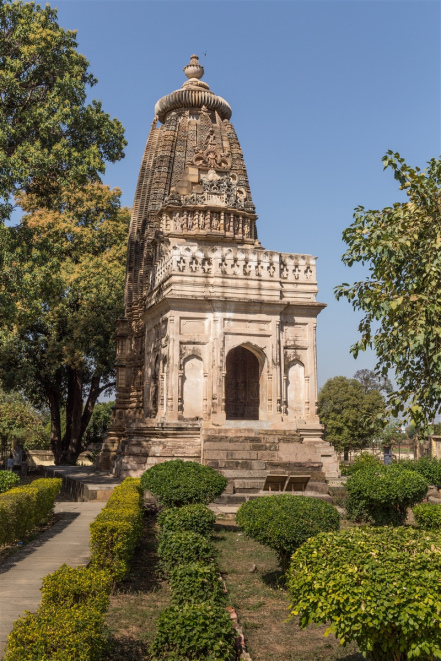Khajuraho Adinatha Temple, Madhya Pradesh

Address
Khajuraho Adinatha Temple Jain Mandir Rd, Eastern Group of Temples, Sevagram, Khajuraho, Madhya Pradesh 471606
Diety
Adinatha
Introduction
The Adinatha Temple, also known as Ādinātha Mandir, is a significant Jain temple situated in Khajuraho, Madhya Pradesh, India. This temple is dedicated to Adinatha, one of the revered tirthankaras in Jainism. However, it’s worth noting that despite its primary dedication to a Jain tirthankara, the exterior walls of the temple also feature sculptures of Hindu deities.
The Adinatha Temple is an integral part of the UNESCO World Heritage Site, which includes several other temples in the Khajuraho Group of Monuments. Khajuraho is renowned for its exquisite temple architecture and intricate sculptures that depict various aspects of life, religion, and art from ancient India. The coexistence of Jain and Hindu elements on the temple’s exterior walls is reflective of the religious and cultural diversity that was characteristic of the region during the period when these temples were constructed.
Puranic Significance
The Adinatha Temple in Khajuraho has a rich historical background and architectural significance.
Dating: The Adinatha Temple is dated to the late 11th century CE, making it an ancient structure that has stood the test of time. It is believed to have been constructed slightly later than the Vamana Temple, another prominent temple in Khajuraho.
Main Deity: Inside the garbhagriha (sanctum sanctorum) of the temple, there is a black schist or basalt statue of Lord Adinath, the first tirthankara in Jainism. The temple is primarily dedicated to Lord Adinath.
Inscription: The temple features a notable three-line inscription that provides valuable historical information. This inscription is dated to samvat 1215, which corresponds to 1158 AD. It mentions the name of the donor as Kumarnandi and identifies the sculptor as Ramaveva. Additionally, the inscription notes that Kumarnandi was the disciple of Bhanukirti, who was in turn a disciple of Rajanandi, and Rajanandi was a disciple of Ramachandra of Mula Sangha. This lineage highlights the transmission of knowledge and skills within the sculptor’s community.
Verses: The inscription includes three shardulavikridita verses in literary Sanskrit, showcasing the cultural and linguistic richness of the period.
Monument of National Importance: The Adinatha Temple has been officially classified as a Monument of National Importance by the Archaeological Survey of India (ASI). This designation recognizes its historical, cultural, and architectural significance within India’s heritage.
The Adinatha Temple in Khajuraho stands as a testament to ancient craftsmanship and religious devotion. Its inscriptions provide valuable insights into the people, culture, and lineage of the artisans who contributed to its construction.
Special Features
The Adinatha Temple in Khajuraho indeed shares a similar plan and design with the Vamana Temple, both being significant examples of temple architecture in the region. While the two temples have many similarities, there are also some distinct differences, as you mentioned
Outer Wall Sculptures: One of the key differences lies in the top row of the outer wall sculptures. In the Adinatha Temple, this row depicts a flying vidyadhara, a celestial being in Hindu and Jain mythology. In contrast, the Vamana Temple showcases diamond-shaped decorations in the same location.
Tower Proportions: The curvilinear tower of the Adinatha Temple is noted to have better proportions than that of the Vamana Temple. This suggests a certain level of refinement and evolution in the architectural style, indicating that the Adinatha Temple may have been constructed after the Vamana Temple.
Sculptural Style: The Adinatha Temple also exhibits a somewhat more evolved sculptural style compared to the Vamana Temple. This reflects changes in artistic techniques and expressions over time.
Iconographic Sculpture: Additionally, the temple features sculptures with unique iconography, including depictions of a yaksha, a yakshini, and a bull with a dharmachakra. These sculptures likely have specific religious and symbolic significance.
Adinatha’s Pose: The main deity, Adinatha, is shown in the padmasana pose, sitting on a cushioned seat adorned with lotuses and diamond motifs. This portrayal highlights the attention to detail and symbolism in the temple’s sculpture.
These differences not only add to the distinct character of the Adinatha Temple but also provide insights into the evolution of architectural and artistic styles in the region. The temple’s unique features and refined design make it a valuable part of Khajuraho’s architectural heritage.
Century/Period/Age
11th century CE
Managed By
Archeological survey of India.
Nearest Bus Station
Sevagram
Nearest Railway Station
Khajuraho
Nearest Airport
Khajuraho




